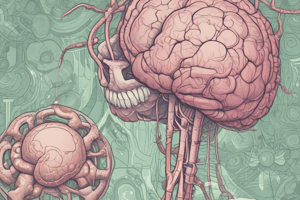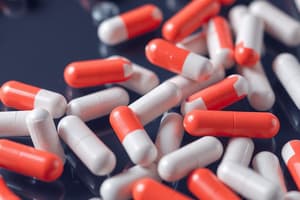Podcast
Questions and Answers
What is the primary reason adrenaline is preferred over noradrenaline in the treatment of anaphylactic shock?
What is the primary reason adrenaline is preferred over noradrenaline in the treatment of anaphylactic shock?
- Adrenaline can stimulate both α and β receptors effectively. (correct)
- Noradrenaline primarily acts on histamine receptors.
- Noradrenaline is ineffective due to low blood pressure.
- Adrenaline has a longer half-life than noradrenaline.
Which characteristic of adrenaline limits its effectiveness when administered orally?
Which characteristic of adrenaline limits its effectiveness when administered orally?
- It is ineffective due to CNS penetration.
- It undergoes rapid oxidation and conjugation in the liver. (correct)
- It is a potent bronchoconstrictor.
- Its half-life is excessively long.
Which of the following statements about noradrenaline is true?
Which of the following statements about noradrenaline is true?
- It can be used for treating asthma by dilating airways.
- It stimulates β2 receptors to reduce blood flow.
- It causes vasodilation at small doses.
- It is suitable for treating cardiogenic shock. (correct)
What is a significant side effect of ephedrine due to its mixed action?
What is a significant side effect of ephedrine due to its mixed action?
What distinguishes dopamine's action compared to norepinephrine at low concentrations?
What distinguishes dopamine's action compared to norepinephrine at low concentrations?
Which route of administration for adrenaline provides the fastest absorption?
Which route of administration for adrenaline provides the fastest absorption?
Why is salbutamol preferred over isoproterenol for treating asthma?
Why is salbutamol preferred over isoproterenol for treating asthma?
Which phenomenon explains the restlessness felt after adrenaline administration?
Which phenomenon explains the restlessness felt after adrenaline administration?
Which statement regarding the metabolism of adrenaline is correct?
Which statement regarding the metabolism of adrenaline is correct?
What is the primary role of VMAT1 and VMAT2 in relation to catecholamines?
What is the primary role of VMAT1 and VMAT2 in relation to catecholamines?
What impact does adrenaline have on blood glucose levels?
What impact does adrenaline have on blood glucose levels?
Which drug is known to irreversibly block the activity of monoamine oxidases (MAOs)?
Which drug is known to irreversibly block the activity of monoamine oxidases (MAOs)?
Which property distinguishes noradrenergic transporters from vesicular transporters?
Which property distinguishes noradrenergic transporters from vesicular transporters?
How do amphetamine and methamphetamine primarily differ from classical sympathomimetics?
How do amphetamine and methamphetamine primarily differ from classical sympathomimetics?
What function do muscarinic receptors primarily serve in the body?
What function do muscarinic receptors primarily serve in the body?
Which of the following drugs blocks noradrenaline transporters (NET)?
Which of the following drugs blocks noradrenaline transporters (NET)?
What effect does the drug reserpine have on catecholamines?
What effect does the drug reserpine have on catecholamines?
What distinguishes nicotinic receptors from muscarinic receptors?
What distinguishes nicotinic receptors from muscarinic receptors?
Which substance primarily competes with catecholamines in non-vesicular release?
Which substance primarily competes with catecholamines in non-vesicular release?
What is a common characteristic of tricyclic antidepressants regarding net transporters?
What is a common characteristic of tricyclic antidepressants regarding net transporters?
What is the primary role of M1 muscarinic receptors in the gastric parietal cells and CNS?
What is the primary role of M1 muscarinic receptors in the gastric parietal cells and CNS?
Which of the following is NOT a consequence of sympathetic stimulation in the body?
Which of the following is NOT a consequence of sympathetic stimulation in the body?
How do M2 and M4 muscarinic receptors primarily affect cellular responses?
How do M2 and M4 muscarinic receptors primarily affect cellular responses?
Which adrenergic agonist is primarily used for managing asthma?
Which adrenergic agonist is primarily used for managing asthma?
Why is adrenaline the first drug of choice for anaphylactic shock over noradrenaline?
Why is adrenaline the first drug of choice for anaphylactic shock over noradrenaline?
Which of the following is a characteristic effect of M3 muscarinic receptors?
Which of the following is a characteristic effect of M3 muscarinic receptors?
Clonidine is primarily used in clinical settings for which condition?
Clonidine is primarily used in clinical settings for which condition?
What is the function of β1 adrenergic agonists, such as dobutamine?
What is the function of β1 adrenergic agonists, such as dobutamine?
What effect does parasympathetic stimulation have on the bronchial muscles?
What effect does parasympathetic stimulation have on the bronchial muscles?
What is the primary action of phenylephrine in a clinical setting?
What is the primary action of phenylephrine in a clinical setting?
Which of the following statements about the effects of amphetamines on the central nervous system is true?
Which of the following statements about the effects of amphetamines on the central nervous system is true?
What is a common side effect of alpha-blockers that is related to their antihypertensive action?
What is a common side effect of alpha-blockers that is related to their antihypertensive action?
What adverse effect is specifically linked to the use of beta-blockers?
What adverse effect is specifically linked to the use of beta-blockers?
Which therapeutic application would NOT typically involve sympathomimetics?
Which therapeutic application would NOT typically involve sympathomimetics?
What is a noted effect of amphetamines at high doses?
What is a noted effect of amphetamines at high doses?
Which treatment is indicated for amphetamine toxicity?
Which treatment is indicated for amphetamine toxicity?
What could be a significant consequence of prolonged use of sympathomimetics?
What could be a significant consequence of prolonged use of sympathomimetics?
Which type of beta-blocker is likely to cause less sedation due to low penetration into the blood-brain barrier?
Which type of beta-blocker is likely to cause less sedation due to low penetration into the blood-brain barrier?
What condition could result from excessive use of sympathomimetics?
What condition could result from excessive use of sympathomimetics?
Which of the following is NOT a common use for beta-agonists?
Which of the following is NOT a common use for beta-agonists?
Flashcards are hidden until you start studying
Study Notes
Catecholamines
- Accumulate in synaptic vesicles via VMAT1 and VMAT2 protonic pumps, which can be targeted pharmacologically.
- Reserpine inhibits catecholamine vesicular transport, leading to their depletion and is used as an antihypertensive.
- Amphetamines and methamphetamine are indirect sympathomimetics that promote non-vesicular catecholamine release and activate the sympathetic system.
Noradrenergic Synapse
- Noradrenaline transporters (NET) are Na+/Cl- dependent and can also reuptake dopamine.
- NET operates at the plasma membrane, while VMAT transports catecholamines within vesicles.
- Desipramine blocks NET; cocaine and methylphenidate inhibit it too.
- MAO inhibitors like iproniazid irreversibly block monoamine oxidases.
Cholinergic Synapses
- Two cholinergic receptor types: muscarinic (metabotropic) and nicotinic (channel-like).
- Muscarinic receptors have subtypes (M1, M2, M3, M4, M5) with distinct roles in the parasympathetic system.
- M1 receptors: CNS involvement; M3 receptors: smooth muscle contractions; M2/M4 receptors: inhibition of adenylyl cyclase, inducing hyperpolarization.
Sympathetic vs. Parasympathetic Effects
- Sympathetic stimulation causes pupil dilation, increased heart rate, bronchodilation, and decreased GI motility.
- Parasympathetic stimulation leads to pupil constriction, bradycardia, bronchoconstriction, and increased GI secretions.
Direct Drugs: Adrenergic Agonists
- Endogenous catecholamines include adrenaline, noradrenaline, and dopamine, with specific receptors and actions.
- Dobutamine: preferentially targets β1 receptors; treats heart failure.
- Isoproterenol: β2 agonist used for asthma treatment.
- Phenylephrine: preferential α1 agonist, used as a nasal decongestant; can cross BBB, causing addiction.
- Clonidine: α2 agonist, used for hypertension and migraine prophylaxis.
Clinical Uses of Adrenergic Drugs
- Adrenaline: first-choice for anaphylactic shock.
- Dobutamine: primary drug for congestive heart failure.
- Salbutamol: selective β2 agonist for asthma relief.
Pharmacokinetics
- Adrenaline is sensitive to UV light and should be administered in small doses.
- Routes of administration are primarily parenteral; oral administration is ineffective due to rapid metabolism.
Endogenous Catecholamines
- Adrenaline: strong stimulator of α and β receptors; used in cardiac arrest and anaphylaxis.
- Noradrenaline: not used for anaphylactic shock; effective for cardiogenic shock.
- Dopamine: improves renal perfusion at low doses; positive inotropic effects at higher concentrations.
Amphetamines
- Indirect sympathomimetic drugs used recreationally; increase sympathetic system activity.
- Can treat ADHD but have high toxicity risks including cardiovascular issues.
Therapeutic Applications of Sympathomimetics
- Used for various shock types, hypotension, hypertension, cardiac arrhythmias, asthma, and certain anxiety disorders.
- Risks include excessive vasoconstriction, cardiac arrhythmias, and CNS-side effects.
Adrenergic Antagonists
- Alpha-blockers: used for benign prostatic hyperplasia and hypertension; may cause retrograde ejaculation.
- Beta-blockers: treat hypertension, arrhythmias, and anxiety; important to monitor for bronchoconstriction, especially in asthmatics.
Conclusion
- Drugs that modulate adrenergic receptors significantly impact cardiovascular and respiratory functions.
- The balance of agonists and antagonists illustrates the need for selective targeting of adrenergic receptors based on therapeutic requirements.
Studying That Suits You
Use AI to generate personalized quizzes and flashcards to suit your learning preferences.




